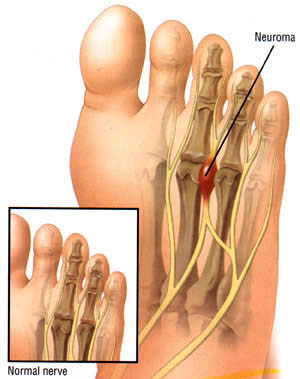Mortons Neuroma
From Fellrnr.com, Running tips
Revision as of 13:57, 30 January 2011 by User:Fellrnr (User talk:Fellrnr | contribs) (Created page with 'Morton's Neuroma is caused by an irritated nerve in the forefoot, usually between the 3rd and 4th metatarsal heads. The pain can be felt near the metatarsal heads, or it can radi…')
Morton's Neuroma is caused by an irritated nerve in the forefoot, usually between the 3rd and 4th metatarsal heads. The pain can be felt near the metatarsal heads, or it can radiate, mostly towards the 3rd and 4th toes.
Here is a cross section of the foot showing the location of the nerve.
The best in-depth information on Morton's Neuroma is from the Google Book's copy of comprehensive textbook of foot and ankle surgery, Volume 2
Suggested treatments
The following are a list of possible approaches to treating a Morton's Neuroma.
- The most important approach is to avoid any footwear that squeezes the forefoot. This will aggravate the nerve, so avoid any shoe that puts any pressure on the sides of the forefoot. It may help to go up a shoe size, or cutting away the shoe where it touches the sides of the forefoot.
- Toe stretches can help spread the metatarsal heads. I've used XXX and it seems to help.
- Many people find that a metatarsal pad in their shoes help relieve the problem. I know of runners who will not run without metatarsal pads.
- Orthotics may help, though I personally dislike orthotics and believe they are likely to cause other problems.
- A simpler alternative to orthotics is to build up the insole of your shoes under the first metatarsal and big toe area. This can reduce the pressure on the nerve. The insole can be build up with layers of duct tape and I know of at least one runner who has benefited from this approach.
- Cortisone injections can help reduce the inflammation of the nerve, but often multiple injections are required.
- Injections of alcohol can be used to kill off (scleros) the nerve.
- If nothing else works, the nerve can be surgically removed, which is generally successful, though there are cases of the end of the removed nerve becoming inflamed and causing problems. If this approach is taken, it is recommended that the nerve is removed through the top of the foot to prevent problems with the sole of the foot and reduce recovery times.
- X-Rays and a professional evaluation can be useful to rule out other possible problems.
- Ice may help, but it does not seem as effective on this problem is it is on muscular problems.
- Strenghtening

